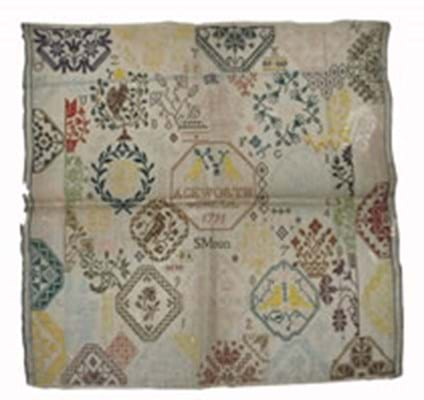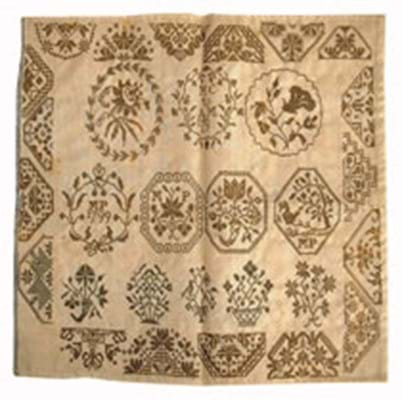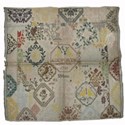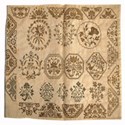While their contemporaries were stitching alphabets, verses, and scenes from the English countryside, the young Quakers of 18th century Ackworth (near Pontefract) were crafting abstract medleys populated by circular and hexagonal medallions, stylised natural forms and intermittent initials.
It is possible that the medallions were taken from watch papers (the often-decorated pieces of paper put inside the outer case of a watch to prevent corrosion). The initials likely refer to the Christian names of friends of the worker and illustrate the strong friendships that grew between pupils in the enclosed atmosphere in the early years of the school.
Ackworth School, founded as a co-educational boarding school in 1779 by the Quaker physician John Fothergill (1712-1780), still thrives today. It is one of eight Quaker boarding schools in England, has 400 students and, with over 100 examples, the largest collection of Ackworth samplers extant.
Jacqueline Holdsworth, a member of the Friends of Ackworth Samplers who has been documenting these imaginative creations for some time, was accordingly keen to acquire the two unframed examples that appeared for sale at Tennants of Leyburn on March 25. Consigned from a private source in the Lake District, they were estimated at just £60-80 each but - aware of the sale at Ackworth Rugby club of another for £4000 (it too was expected to make just £40) - she was expecting to pay much more.
The school was just a decade old when Sarah Moon (she attended Ackworth from 1789-1793) stitched her sampler in 1791. In colourful cross-stitched silk threads she had chosen a 13in x 121/2in (32.5cm x 31.5cm) design of medallions populated by birds, plants, geometric motifs plus the various initials of her classmates and the inscription Ackworth School 1791 S Moon. Instead of £80, it sold at £8500 (plus 15% buyer's premium) after competition from six telephone bidders and three serious contenders in the room.
Another smaller 91/2in x 10in (24cm x 25cm) example from 1799 was worked in brown silk (many Ackworth samplers are monochrome) and stitched with the initials MP 1799, and MC to AM 1799 among flowering plants. Offered together with an alphabet sampler, it fetched £4000.
Almost £15,000 lighter, Ms Holdsworth is returning both samplers to the school archive that (since the targeted theft of two samplers from the school walls) is kept off-site under lock and key.
Ms Holdsworth views samplers like scattered jigsaw pieces and her goal is to bring together as many as possible so that needlework techniques, patterns of teaching, provenance of threads and dyes, and motifs can be examined in a defined context.
"What is special about Ackworth School is that we have a richness of context in terms of school documents and other items made by the girls so that the samplers can be better understood as a group and through them the life of the girls told," she told ATG.
"We can study the influences of teachers and their relationships with other Quaker schools in England, Europe and America. It is this context that gives the sampler any value over and above its decorative value alone."
All of the recently purchased samplers will be incorporated into a book Ackworth School Samplers currently being written by Carol Humphrey of the Fitzwilliam Museum, Cambridge, and published later this year by Ms Holdsworth. She invites anyone in possession of an Ackworth School or other Quaker sampler to send images to needleprint@holdsworth3311.freeserve.co.uk.
An Ackworth School lesson for Tennants
Whether it was the result of quiet, pious reflection, plentiful practice, or simply the bonds between close friends, the samplers produced by the girls of Ackworth School in West Yorkshire developed a distinct individual style.








